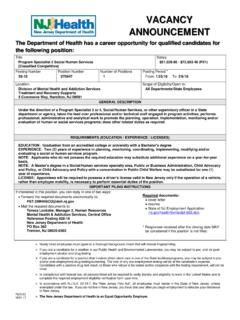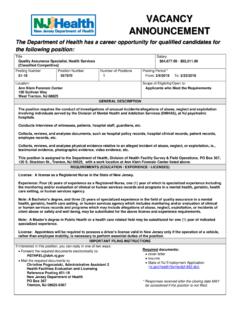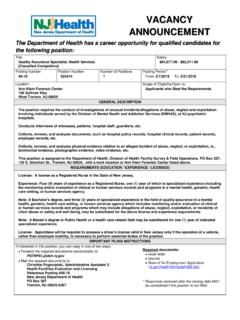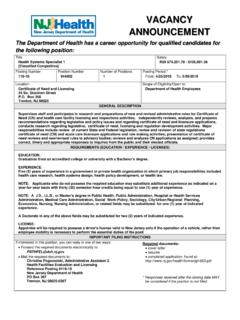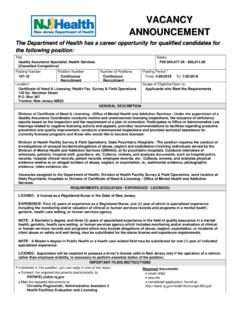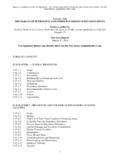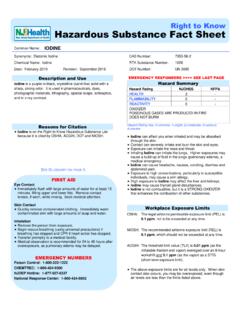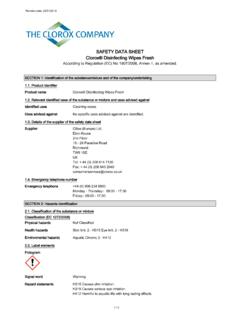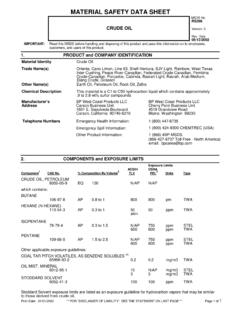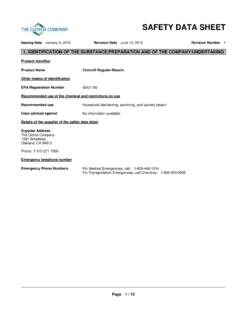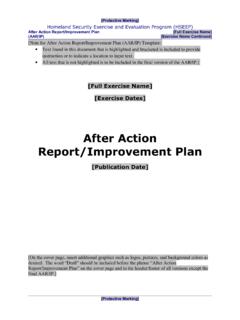Transcription of IRON OXIDE HAZARD SUMMARY Iron Oxide
1 Common Name: iron OXIDE CAS Number: 1309-37-1 DOT Number: None DOT HAZARD Class: None ---------------------------------------- --------------------------------- HAZARD SUMMARY * iron OXIDE can affect you when breathed in. * Exposure to iron OXIDE fumes can cause metal fume fever. This is a flu-like illness with symptoms of metallic taste, fever and chills, aches, chest tightness and cough. * prolonged or repeated contact can discolor the eyes causing permanent iron staining. * Repeated exposure to iron OXIDE fume or dust can cause pneumoconiosis (Siderosis) with cough, shortness of breath and changes on chest x-ray.
2 * iron OXIDE as Ferric OXIDE (Fe2O3) is not combustible, unless finely powdered. However, Ferrous OXIDE (FeO) is extremely flammable and reactive, and may ignite spontaneously in air. IDENTIFICATION iron OXIDE is a black crystal or a reddish-brown powder. It is used in polishing compounds, pigments, and metallurgy. iron OXIDE fume is produced when materials containing iron are heated, as in arc welding. DOT number UN 1376 refers to Ferrous OXIDE (FeO), iron OXIDE (Spent) or iron Sponge. Ferrous OXIDE (FeO) may be formed in Oxygen-limited atmospheres, in flue gas, and from coal gas purification.
3 iron OXIDE (Spent) or iron Sponge is produced when iron Ore is heated below the melting point of iron . With further processing, they become Wrought iron . REASON FOR CITATION * iron OXIDE is on the Hazardous Substance List because it is regulated by OSHA and cited by ACGIH, NIOSH and IARC. * Definitions are provided on page 5. HOW TO DETERMINE IF YOU ARE BEING EXPOSED The New Jersey Right to Know Act requires most employers to label chemicals in the workplace and requires public employers to provide their employees with information and training concerning chemical hazards and controls.
4 The federal OSHA HAZARD Communication Standard (29 CFR ) requires private employers to provide similar training and information to their employees. RTK Substance number: 1036 Date: August 1998 Revision: May 2007 ---------------------------------------- --------------------------------- * Exposure to hazardous substances should be routinely evaluated. This may include collecting personal and area air samples. You can obtain copies of sampling results from your employer. You have a legal right to this information under the OSHA Access to Employee Exposure and Medical Records Standard (29 CFR ).
5 * If you think you are experiencing any work-related health problems, see a doctor trained to recognize occupational diseases. Take this Fact Sheet with you. WORKPLACE EXPOSURE LIMITS The following exposure limits are for iron OXIDE (measured as iron ): OSHA: The legal airborne permissible exposure limit (PEL) is 10 mg/m3 averaged over an 8-hour workshift. NIOSH: The recommended airborne exposure limit is 5 mg/m3 averaged over a 10-hour workshift. ACGIH: The recommended airborne exposure limit is 5 mg/m3 (as the respirable fraction) averaged over an 8-hour workshift.
6 WAYS OF REDUCING EXPOSURE * Where possible, enclose operations and use local exhaust ventilation at the site of chemical release . If local exhaust ventilation or enclosure is not used, respirators should be worn. * Wear protective work clothing. * Wash thoroughly at the end of the workshift. * Post HAZARD and warning information in the work area. In addition, as part of an ongoing education and training effort, communicate all information on the health and safety hazards of iron OXIDE to potentially exposed workers. iron OXIDE page 2 of 6 This Fact Sheet is a SUMMARY source of information of all potential and most severe health hazards that may result from exposure.
7 Duration of exposure, concentration of the substance and other factors will affect your susceptibility to any of the potential effects described below. Metal, metal compounds and alloys are often used in hot operations in the workplace. These may include, but are not limited to, welding, brazing, soldering, plating, cutting, and metallizing. At the high temperatures reached in these operations, metals often form metal fumes which have different health effects and exposure standards than the original metal or metal compound and require specialized controls. Your workplace can be evaluated for the presence of particular fumes which may be generated.
8 Consult the appropriate New Jersey Department of Health and Senior Services Hazardous Substance Fact Sheets. ---------------------------------------- ---------------------------------- HEALTH HAZARD INFORMATION Acute Health Effects The following acute (short-term) health effects may occur immediately or shortly after exposure to iron OXIDE : * Exposure to iron OXIDE fumes can cause metal fume fever. This is a flu-like illness with symptoms of metallic taste, fever and chills, aches, chest tightness and cough. Chronic Health Effects The following chronic (long-term) health effects can occur at some time after exposure to iron OXIDE and can last for months or years: Cancer HAZARD * While iron OXIDE has been tested, it is not classifiable as to its potential to cause cancer.
9 Reproductive HAZARD * According to the information presently available to the New Jersey Department of Health and Senior Services, iron OXIDE has not been tested for its ability to affect reproduction. Other Long-Term Effects * prolonged or repeated contact can discolor the eyes, causing permanent iron staining. * Repeated exposure to iron OXIDE fume or dust can cause pneumoconiosis (Siderosis) with cough, shortness of breath and changes on chest x-ray. MEDICAL Medical Testing For those with frequent or potentially high exposure (half the PEL or greater), the following are recommended before beginning work and at regular times after that: * Lung function tests Any evaluation should include a careful history of past and present symptoms with an exam.
10 Medical tests that look for damage already done are not a substitute for controlling exposure. Request copies of your medical testing. You have a legal right to this information under the OSHA Access to Employee Exposure and Medical Records Standard (29 CFR ). Mixed Exposures * Because smoking can cause heart disease, as well as lung cancer, emphysema, and other respiratory problems, it may worsen respiratory conditions caused by chemical exposure. Even if you have smoked for a long time, stopping now will reduce your risk of developing health problems. WORKPLACE CONTROLS AND PRACTICES Unless a less toxic chemical can be substituted for a hazardous substance, ENGINEERING CONTROLS are the most effective way of reducing exposure.
